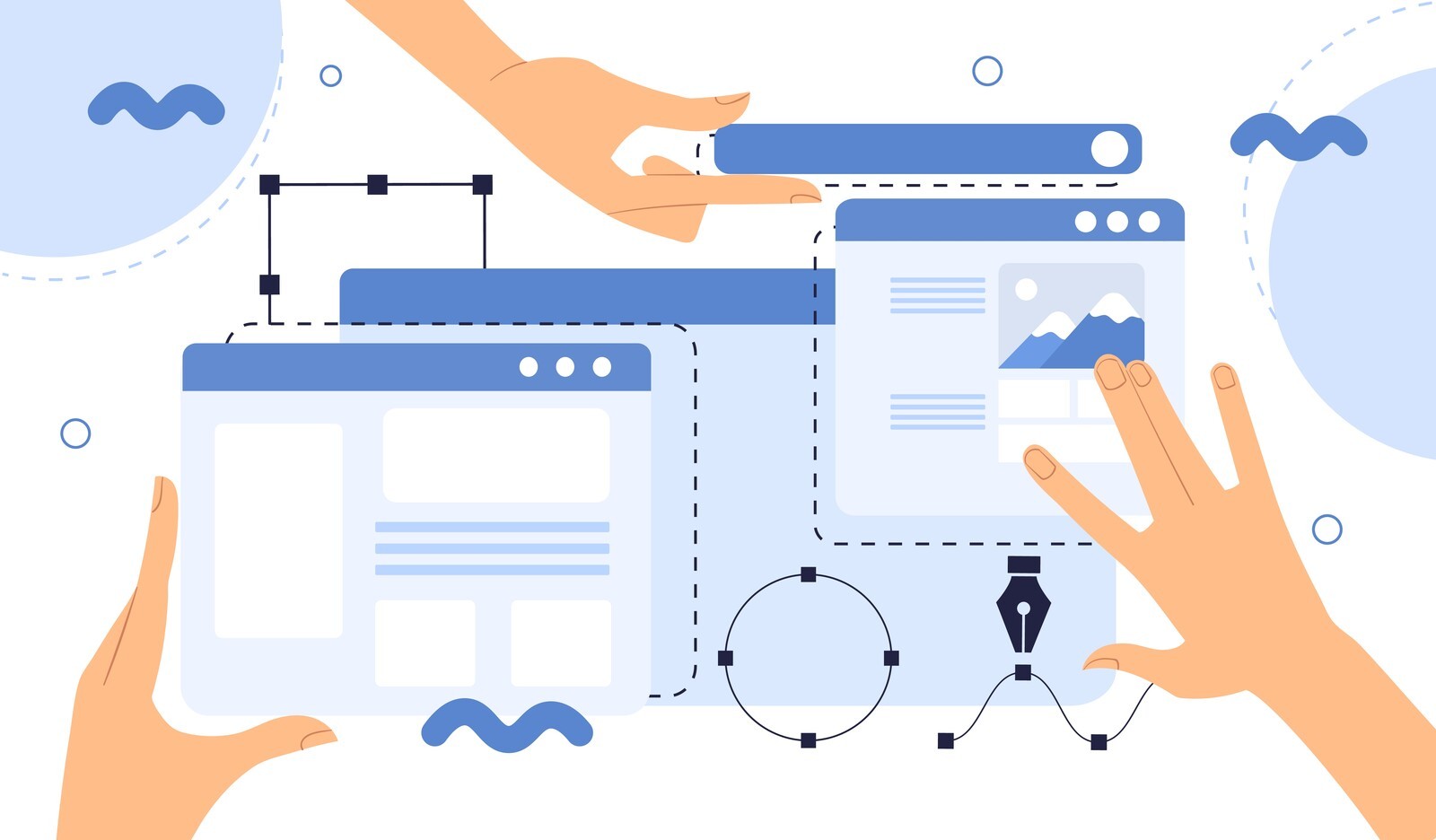A website acts as the online storefront for your business. It is often the first point of contact potential customers have with your brand. But what happens when your digital storefront begins to look outdated, perform poorly, or simply doesn't align with your business goals anymore? This is where the need for a website redesign comes into play.
A well-planned website redesign can significantly enhance your site's aesthetics, functionality, and overall user experience, leading to improved user engagement and conversion rates.
Reasons for a Website Redesign
Before starting on the website redesign journey, it's crucial to identify the reasons behind this decision. Some common reasons that often trigger a website redesign:
- Outdated Website Design
An outdated look can harm your brand's online reputation and user experience. - Poor Performance
Slow load times and frequent downtime can negatively impact user experience and SEO. - Inadequate Mobile Responsiveness
In today's mobile-first world, a website not optimized for mobile devices can lead to significant user loss. - Ineffective User Navigation
If users find it hard to navigate and find relevant information, a redesign focusing on user experience (UX) is needed. - Rebranding
If your business has undergone rebranding, your website should reflect these changes. - Low Conversion Rates
If your website isn't converting visitors into customers effectively, it may be time to rethink your site design and functionality. - New Business Goals or Strategies
As your business evolves, your website may need to adapt to accommodate new goals or strategies.
Setting Your Redesign Goals
Clear, measurable goals not only guide the direction of your redesign but also provide a benchmark against which you can measure the success of the project.
These goals should be in line with your overall business objectives and could include aspects like increasing conversion rates, enhancing user engagement, or improving website accessibility.
Here are a few potential goals you might consider for your website redesign:
- Improve User Experience
Streamline navigation, reduce load times, and make your site easier to use. - Increase Conversion Rates
Redesign your site to better guide users towards desired actions, such as making a purchase or subscribing to a newsletter. - Enhance Branding
Update your site's design to better reflect your brand identity and values. - Optimize for Mobile
Ensure your site provides a smooth and efficient experience on mobile devices. - Boost Search Engine Rankings
Implement SEO best practices to improve your site's visibility on search engines. - Improve Site Security
Incorporate the latest security measures to protect your site and users' data.
Analyzing Your Current Website
 One of the first steps in planning a website redesign is to conduct a thorough analysis of your existing site, commonly known as a SWOT analysis (Strengths, Weaknesses, Opportunities, and Threats).
One of the first steps in planning a website redesign is to conduct a thorough analysis of your existing site, commonly known as a SWOT analysis (Strengths, Weaknesses, Opportunities, and Threats).
- Strengths
Identify what's currently working well on your website. This could be anything from effective SEO strategies to compelling content that engages your users. - Weaknesses
Pinpoint areas of your website that are underperforming or causing issues. This could include slow load times, confusing navigation, or outdated design elements. - Opportunities
Look for elements that could be introduced or improved upon in your redesign. For example, you might identify the opportunity to implement a more efficient content management system or to enhance your site's mobile responsiveness. - Threats
Consider external factors that could negatively affect your website's performance or your online presence. This could include changes in Google's algorithm, emerging competitor websites, or evolving user expectations.
Understanding your website's current state will provide a solid foundation for your redesign, helping you focus on areas that need improvement and capitalize on opportunities for growth.
Identifying Your Target Audience
Understanding your target audience is a crucial aspect of any website redesign. Your website should be tailored to meet the needs and expectations of your ideal customers, as this will greatly enhance user experience and lead to increased conversions.
Here's a simple step-by-step process for creating audience personas:
- Identify your ideal customers
Look at your existing customer base and identify the individuals or businesses that best represent your ideal customers. - Research their needs and preferences
Use surveys, interviews, or market research to understand what these individuals or businesses are looking for in a website like yours. - Create detailed personas
Based on your research, create detailed personas that represent your ideal customers. Include information such as demographics, needs, preferences, and behaviours. - Use personas in your redesign
Keep these personas in mind throughout your redesign process to ensure your website is tailored to their needs and preferences.
Reviewing Your Competitors
Conducting a competitive analysis as part of your website redesign planning is beneficial for several reasons. Not only does it provide you with a wealth of ideas for your own redesign, but it also helps you understand industry standards, identify trends, and see what strategies are working well for others in your field.
A few key aspects to focus on when reviewing competitor websites:
- Design and Layout
Look at the aesthetics of their websites. How do they use color, imagery, and typography? What is the general layout of their pages? - Content
What kind of content are they producing? How is it structured on their site? Is it engaging and informative? - User Experience
How easy is it to navigate their site? How quickly do pages load? Is it mobile-friendly? - SEO
What keywords are they ranking for? Are they following SEO best practices? - Unique Selling Propositions
What sets them apart from others? What unique features or offerings do they have?
By understanding what your competitors are doing, you can gain valuable insights to guide your own website redesign and ensure you stay competitive in your industry.
Determining Functional and Design Requirements
Once you've set your goals, understood your audience, and analyzed your current website and competitors, it's time to outline your specific functional and design requirements.
These will act as a roadmap for your web development partner and will directly influence the effectiveness of your redesigned website. Here are a few functional requirements you might consider:
- Mobile Responsiveness
Your website should be accessible and user-friendly on all types of devices. - SEO-friendly Structure
Your site should be designed with SEO best practices in mind to improve its search engine ranking. - Fast Load Times
Page load speed impacts both user experience and SEO. - Easy Navigation
Users should be able to quickly and easily find the information they need. - Secure Transactions
If your site involves any form of transaction, it needs to be secure. - Integrated CMS
An efficient Content Management System will make it easier to update and manage your site.
When it comes to design, focusing on User Experience (UX) is paramount. Your site needs to be visually appealing, but also intuitive and easy to navigate. Prioritize simplicity and clarity over complexity and remember that every design choice should serve a purpose and contribute to the overall user experience.
Choosing the Right Web Development Partner
Selecting a web development agency is a critical step in your website redesign process.
- Experience and Expertise
Look for an agency with a proven track record in web design and development. They should have the skills and expertise to bring your vision to life. - Portfolio
Review their previous work to see if their style aligns with your vision and to assess the quality of their work. - References and Reviews
Check testimonials and reviews from their past clients. - Communication and Collaboration
Your agency should be easy to communicate with and open to your ideas. They should also be able to clearly explain technical aspects to you. - Timeline and Budget
Ensure they can work within your budget and complete the project within your desired timeline. - Support and Maintenance
Check if they provide ongoing support and maintenance services after the site goes live.
The right partner will not only deliver a website that meets your functional and design requirements but will also provide ongoing support to ensure your site remains effective and up-to-date.
Creating a Project Timeline
Establishing a realistic timeline is critical for a successful website redesign. It not only keeps the project on track but also ensures that every stage of the redesign is given adequate attention. A quality website redesign can't be rushed.
Some key milestones that you might include in your project timeline:
- Project Kick-off
Official start of the project and finalization of the website redesign plan. - Design Phase
Creation of design mock-ups and prototypes. - Development Phase
Actual coding and building of the website. - Content Integration
Addition of text, images, videos, etc. - Testing
Comprehensive review of the website’s functionality and user experience. - Launch
Official release of the new website to the public. - Post-Launch Evaluation and Maintenance
Monitoring website performance and making necessary adjustments.
Planning for SEO and Website Security
SEO and security are two critical components of any website redesign. They should be incorporated right from the planning stage, not as an afterthought.
SEO is essential for increasing your website's visibility on search engines, driving more traffic, and ultimately, achieving your business goals. Consider factors such as keyword optimization, meta tags, and URL structure.
Security, on the other hand, is paramount for protecting your website and users' data. Security measures include SSL certification, regular software updates, and strong password policies.
Embarking on a website redesign is a significant endeavour that requires careful planning and preparation. By understanding your reasons for a redesign, setting clear goals, knowing your target audience, conducting a SWOT and competitor analysis, determining your functional and design requirements, and choosing the right web development partner, you set the stage for a successful project.
Creating a realistic timeline and incorporating SEO and security considerations into your redesign plan further ensure that your new website will not only meet but exceed expectations. Remember, a well-planned website redesign can dramatically improve your online presence, enhance user experience, and drive your business goals forward.
Take your time, plan carefully, and get ready to make a powerful impact with your redesigned website!




